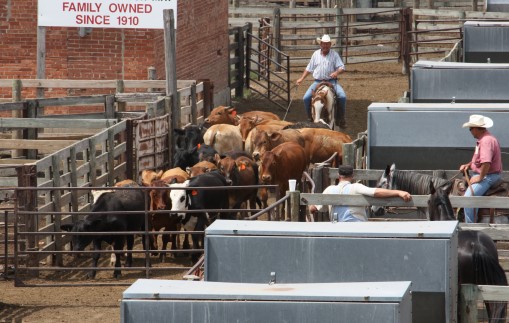
Agricultural News
Transition in Beef Industry Causing Fear and Uncertainty in Cattle Markets
Mon, 03 Oct 2016 10:22:44 CDT
 Mondays, Dr. Derrell Peel, Oklahoma State University Extension Livestock Marketing Specialist, offers his economic analysis of the beef cattle industry. This analysis is a part of the weekly series known as the "Cow Calf Corner" published electronically by Dr. Peel and Dr. Glenn Selk. Today, Dr. Peel offers a little perspective on the fear and uncertainty in the cattle markets being caused by recent bearish activity.
Mondays, Dr. Derrell Peel, Oklahoma State University Extension Livestock Marketing Specialist, offers his economic analysis of the beef cattle industry. This analysis is a part of the weekly series known as the "Cow Calf Corner" published electronically by Dr. Peel and Dr. Glenn Selk. Today, Dr. Peel offers a little perspective on the fear and uncertainty in the cattle markets being caused by recent bearish activity.
"The beef industry's transition to larger beef supplies in 2016 has been challenging. A persistently bearish psychology and ridiculous volatility in live and feeder cattle futures recently has contributed to a meltdown in cash markets and a mood among producers that is best described as fear. As a result some producers (and lenders) seem unable to do much of anything at this time. There seems to be a fear that that there is no bottom to markets once the cow herd expands and beef production starts to rise. Perhaps the fact that the industry has not experienced a cyclical expansion since the early 1990s is part of the problem. Some younger producers and traders have never participated in herd expansion and no one in the industry has in more than 20 years. There seems to be a feeling that any data with a positive year over year change (herd inventory, cattle slaughter, beef production, feedlot placements, etc.) is cause for rampant bearishness.
"A little perspective is in order. The beef cow herd is probably still expanding in 2016. There is no way to be sure since USDA-NASS has not provided any inventory update since January. Nevertheless, the beef cow herd is expected to grow another 1.5-2.5 percent in 2016. Added to the expansion in 2014 and 2015, the January 1, 2017 beef cow herd inventory is likely to be near 31 million head. This puts the beef cow herd inventory back to the level at the beginning of 2011; before drought liquidation dropped the herd by an unplanned 2 million head. Although the expansion since 2014 is properly characterized as cyclical expansion, it can also be thought of drought recovery so far. There is little doubt that the herd was poised to expand in 2011 in the absence of drought so it hardly seems likely that expansion to get back to that level can be thought of as drastically overshooting the mark. True, the sharp jump in carcass weights recently (steer carcass weights increased 28 pounds from 2013 to 2015) means that less expansion now will be required to produce the needed total level of beef production. The need for additional herd expansion in 2017 and 2018 is questionable but the expansion thus far is not too much.
"Beef production is expected to increase 4.5 to 5 percent year over year in 2016. This follows a 7.9 percent decrease in beef production from 2013-2015 to a 22 year low. 2016 beef production is projected to be about 24.8 billion pounds and, despite the year over year increase, is still 4.7 percent below the average beef production level from 2009-2013. Domestic and international demand growth in the next couple of years will determine what beef production level is needed but it's clear that we are not at that level yet.
"There is reason for cattle and beef markets to stabilize. Current cattle carcass weights are 15 pounds below this time last year and are expected to remain below year earlier levels for the balance of the year. Year over year cattle slaughter rates for the rest of 2016 will still be higher than last year but will moderate and combined with lower carcass weights are expected to hold fourth quarter beef production to less than 3 percent year over year increase compared to the 7.4 percent increase in the third quarter. Beef imports are down (12.1 percent less through July) and beef exports are improving (up 3.1 percent through July) thus moderating beef supply increases in domestic markets. This is expected to hold the 2016 domestic beef consumption increase to under two percent year over year. Fewer cattle are being imported this year from both Mexico and Canada with Mexican feeder cattle imports down roughly 25 percent so far this year. This helps moderate the increase in domestic feeder supplies going into 2017. The market shock absorbers are in place and working and should help cattle and beef markets move forward with much less drama compared to the past few months.
"The supply challenges going forward mean that caution on the part of producers and lenders is advised and warranted. However, the growth in cattle inventories and beef production thus far do not constitute a wreck and paralyzing fear that cripples decision-making may prevent producers from taking advantage of opportunities that inevitably exist in changing market conditions. We've been through this before-just not in a long time."
WebReadyTM Powered by WireReady® NSI
Top Agricultural News
More Headlines...




















